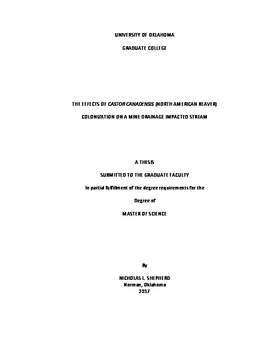| dc.description.abstract | This study investigated four aspects of North American Beaver (Castor canadensis) colonization: (1) retention of metals in-stream due to the presence of dams, (2) metals contamination and leachability of sediments (3) potential for metal mobilization during dam destruction and (4) hydrologic and habitat alterations due to the presence of dams. The study was conducted on an Unnamed Tributary impacted by net alkaline mine drainage since 1979 and was colonized by beaver in late 2013. By the end of 2014, most of the tributary was transformed into a series of impoundments due to beaver dams. By August 2016, the stream had eleven dams impounding water along the one-mile long study reach. The tributary flows into Tar Creek, located within the Tar Creek Superfund Site, which is the Oklahoma portion of the abandoned Tri-State Lead Zinc Mining District. The study found: (1) The presence of beaver dams showed a decrease in Fe and Cd concentrations, with minimal effect on Pb concentrations. The beaver dam with the greatest initial concentrations had mean Fe and Cd removal efficiencies of 57% and 63%, respectively. (2) Stream sediments contained elevated Cd, Pb, and Zn concentrations, with many of the metals concentrations more than five times the EPA site specific guidelines for probable effects concentrations (PEC) of 11.1 mg Cd/kg, 150 mg Pb/kg, and 2,083 mg Zn/kg. Fe concentrations in five of 13 sediment samples exceeded 200,000 mg/kg. The metals had greater concentrations in sediments at the dam outflow compared to the dam inflow. The leachate from a single sediment sample exceeded the Resource Conservation and Recovery Act (RCRA) Cd standard for Toxicity Characteristic Leaching Procedure (TCLP) with 1.08 mg/L compared to the threshold of 1.0 mg/L. (3) Beaver dam removal caused Fe and Cd concentrations to increase over time and remain elevated for the six-hour sampling period. (4) The EPA rapid habitat assessment in presence of beaver dams had a higher habitat score compared to the absence of dams, however the difference between each category was not statistically significant (p=0.26). The presence of beaver dams resulted in a 23% longer mean retention time using a conservative tracer and increased the storage capacity of the stream by 250% (2,500 m3). The study highlights the potentially important role beaver can play in the treatment of mine drainage. As ecosystem engineers, their dam building activities impound water which contributes to decreased metals concentrations. | en_US |
